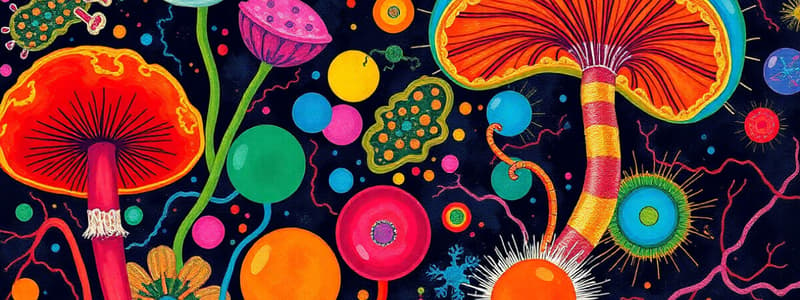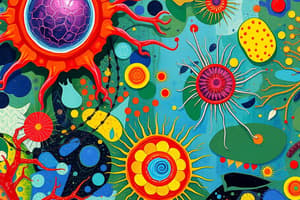Podcast
Questions and Answers
Which of the following is NOT a type of fungi?
Which of the following is NOT a type of fungi?
- Yeast
- Algae (correct)
- Mold
- Mushrooms
Viruses are non-cellular microbes.
Viruses are non-cellular microbes.
True (A)
Protozoa and algae can be seen with a naked eye.
Protozoa and algae can be seen with a naked eye.
True (A)
Mites and roundworms are microbes.
Mites and roundworms are microbes.
What is the name of the theory that states that specific diseases are caused by microscopic "germs"?
What is the name of the theory that states that specific diseases are caused by microscopic "germs"?
Which of the following is NOT a limitation of Koch's postulates?
Which of the following is NOT a limitation of Koch's postulates?
What is the name of the process where weakened or inactive forms of a pathogen are introduced into the body to stimulate an immune response?
What is the name of the process where weakened or inactive forms of a pathogen are introduced into the body to stimulate an immune response?
Who developed the first rabies vaccine?
Who developed the first rabies vaccine?
What is the chemical that was purified from a mold that has been credited with saving countless lives?
What is the chemical that was purified from a mold that has been credited with saving countless lives?
Overreliance on antibiotics can lead to antibiotic resistance.
Overreliance on antibiotics can lead to antibiotic resistance.
Flashcards
Eukaryotic microbes: Protozoa and Algae
Eukaryotic microbes: Protozoa and Algae
Single-celled eukaryotic organisms, often found in aquatic environments. They can be photosynthetic (algae) or heterotrophic (protozoa). Some have complex life cycles and can cause diseases.
Yeast
Yeast
Microscopic fungi that are single-celled and reproduce by budding.
Mold
Mold
Multicellular filaments of fungal cells called hyphae, which often grow on surfaces and produce spores.
Mushrooms
Mushrooms
Signup and view all the flashcards
Viruses
Viruses
Signup and view all the flashcards
Viral Replication
Viral Replication
Signup and view all the flashcards
Biofilms
Biofilms
Signup and view all the flashcards
Mycelium
Mycelium
Signup and view all the flashcards
Germ Theory
Germ Theory
Signup and view all the flashcards
Koch's Postulates
Koch's Postulates
Signup and view all the flashcards
Immunization
Immunization
Signup and view all the flashcards
Antibiotics
Antibiotics
Signup and view all the flashcards
Antibiotic Resistance
Antibiotic Resistance
Signup and view all the flashcards
Antivirals
Antivirals
Signup and view all the flashcards
Antifungals
Antifungals
Signup and view all the flashcards
Antiprotozoals
Antiprotozoals
Signup and view all the flashcards
Sterilization
Sterilization
Signup and view all the flashcards
Medical Microbiology
Medical Microbiology
Signup and view all the flashcards
Immunology
Immunology
Signup and view all the flashcards
Attenuation
Attenuation
Signup and view all the flashcards
Antiseptics
Antiseptics
Signup and view all the flashcards
Disinfectants
Disinfectants
Signup and view all the flashcards
Antibiotic Treatment
Antibiotic Treatment
Signup and view all the flashcards
Immunity
Immunity
Signup and view all the flashcards
Pathogen
Pathogen
Signup and view all the flashcards
Epidemiology
Epidemiology
Signup and view all the flashcards
Epidemic
Epidemic
Signup and view all the flashcards
Pandemic
Pandemic
Signup and view all the flashcards
Virulence
Virulence
Signup and view all the flashcards
Microscopy
Microscopy
Signup and view all the flashcards
Study Notes
Eukaryotic Microbes
- Fungi include yeasts, molds, and mushrooms
- Protozoa include Plasmodium
- Algae are a type of microbe
- Viruses are composed of genetic material (DNA or RNA), a protein shell, and sometimes a lipid envelope
- Viruses are non-metabolic and cannot reproduce independently
- Viruses invade cells to reproduce
- Viruses are non-cellular microbes
Representative Sizes of Microbes
- 1 μm = 1,000 nm
- Microbes can vary in size, with some visible to the naked eye (like some protozoa and algae), and others (like many bacteria) requiring a microscope.
- Microbes' sizes range greatly from visible to almost invisible to the naked eye
Other Challenges with Microbe Definitions
- Some microbes form biofilms, which are made of cells with various functions
- Some microbes grow in mycelial filamentous structures
- Some microbes (like some protozoa and algae) are visible to the naked eye
- Animals, mites, and roundworms are not considered microbes
Microbes Shape Human History
- Microbes play a crucial role in maintaining life
- They fix nitrogen, release oxygen, degrade organic matter, and build organic matter
Medical Microbiology and Immunology
- Germ theory: Specific diseases are caused by microscopic organisms
- Diseases like cholera, HIV, and more have significance in crowded areas during times of conflict
- Florence Nightingale's work demonstrated the significance of sanitation in reducing mortality rates
- Robert Koch developed a scientific method to establish the cause of infectious disease
Koch's Postulates
- Microorganisms identified with disease must be consistently found in every case of the disease
- Microorganisms must be grown in pure culture
- Introduction of the pure culture to healthy individuals must cause the same disease in the healthy individual
- Microorganisms must be isolated from the affected individuals and confirmed in a pure culture
Controlling Infectious Diseases
- Prevention includes immunization, hygienic practices, and sterilization
- Treatment involves antivirals, antifungals, antiprotozoals, and antibiotics
Vaccines
- Edward Jenner developed the concept of vaccination by using cowpox to prevent smallpox
- Louis Pasteur developed attenuated vaccines to induce immunity without causing severe symptoms
- Rabies is a disease which vaccines were developed for and attenuated vaccines are used today
- Microbes can cause disease and be useful and have played and continue to play a crucial role in human history.
Antiseptics and Disinfectants
- John Snow stopped a cholera epidemic by identifying its cause and preventing access to the source
- Ignaz Semmelweis and Joseph Lister improved hygiene practices to prevent surgical infections
- Alexander Fleming discovered penicillin, which revolutionized medicine by fighting bacterial infections
Antibiotics
- Penicillin, discovered by Alexander Fleming, was later purified and mass-produced by Florey and Chain.
- Overuse of antibiotics can lead to antibiotic resistance rendering many bacteria, or other microbes unable to be treated, thus limiting the usefulness of such treatments.
Studying That Suits You
Use AI to generate personalized quizzes and flashcards to suit your learning preferences.




